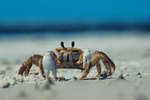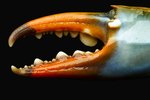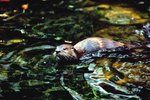
Blue crabs (Callinectes sapidus) can be found in brackish and ocean waters along the coast of the Western Hemisphere. These crabs support both commercial fisheries and recreational fishermen. Crabs start as eggs and move into various larval and adult life stages. Each stage of growth makes them susceptible to different types of predators. Small fish and jellyfish will eat blue crab larvae, while birds, mammals and larger fish will eat older crabs.
Humans
The biggest predators of blue crabs are humans. Commercial crabbing and loss of habitat have dramatically decreased some blue crab populations. The Chesapeake Bay had a heavy decline in the 1990s, going from a high of nearly 800 million crabs in 1992 to about 250 million in 2000. Since the decline of blue crab numbers, watermen have been catching 62 percent of blue crabs in some locations, while regulations allow only 46 percent of crabs to be harvested.
Fish
Fish claim the lives of large numbers of blue crabs, especially when the crabs are small or molting (shedding their hard outer shells to enable growth). Immediately after molting their bodies are soft, which makes them vulnerable to predators. Fish, such as red drum, croakers, striped bass, eels and sharks prey on all growth stages of blue crabs.
Birds
Blue crabs live in coastal waters and tidal rivers. Thus coastal birds enjoy feasting on larvae offshore, young growing crabs on sedimented shorelines and adults in seagrass beds or marshes. Herons, egrets and diving ducks have been seen eating blue crabs. Herons will stab crabs and crunch up the shells with their large beaks before swallowing them whole.
Turtles
Many sea turtles will eat blue crabs as part of their diets, with the exception of the green sea turtles that eat only plants. Turtles that eat blue crabs include the Atlantic ridley and loggerhead turtles. Crab-eating turtles have rigid jaws, or beaks, specifically adapted for use in crushing and grinding hard-shelled prey.
Other Predators
This species has been known to be highly cannibalistic. Larger blue crabs prey on younger ones, which can account for a large percentage of juvenile mortality. Also, shrimp will eat the larvae. Other coastal water inhabitants prey on blue crabs as well. Raccoons who wander down to the water's edge will often eat blue crabs, as will both otters and alligators.
References
- The Institute for Marine Mammal Studies: Blue Crab [PDF]
- South Carolina Department of Natural Resources: Blue Crabs
- Chesapeake Bay Foundation: Bad Water and the Decline of Blue Crabs in the Chesapeake Bay [PDF]
- Center for Environmental and Estuarine Studies, University of Maryland: Blue Crab [PDF]
- National Oceanic and Atmospheric Administration: Blue Crab
Photo Credits
-
Jeffrey Hamilton/Lifesize/Getty Images
Writer Bio
Based in Michigan, Keri Gardner has been writing scientific journal articles since 1998. Her articles have appeared in such journals as "Disability and Rehabilitation" and "Journal of Orthopaedic Research." She holds a Master of Science in comparative medicine and integrative biology from Michigan State University.




